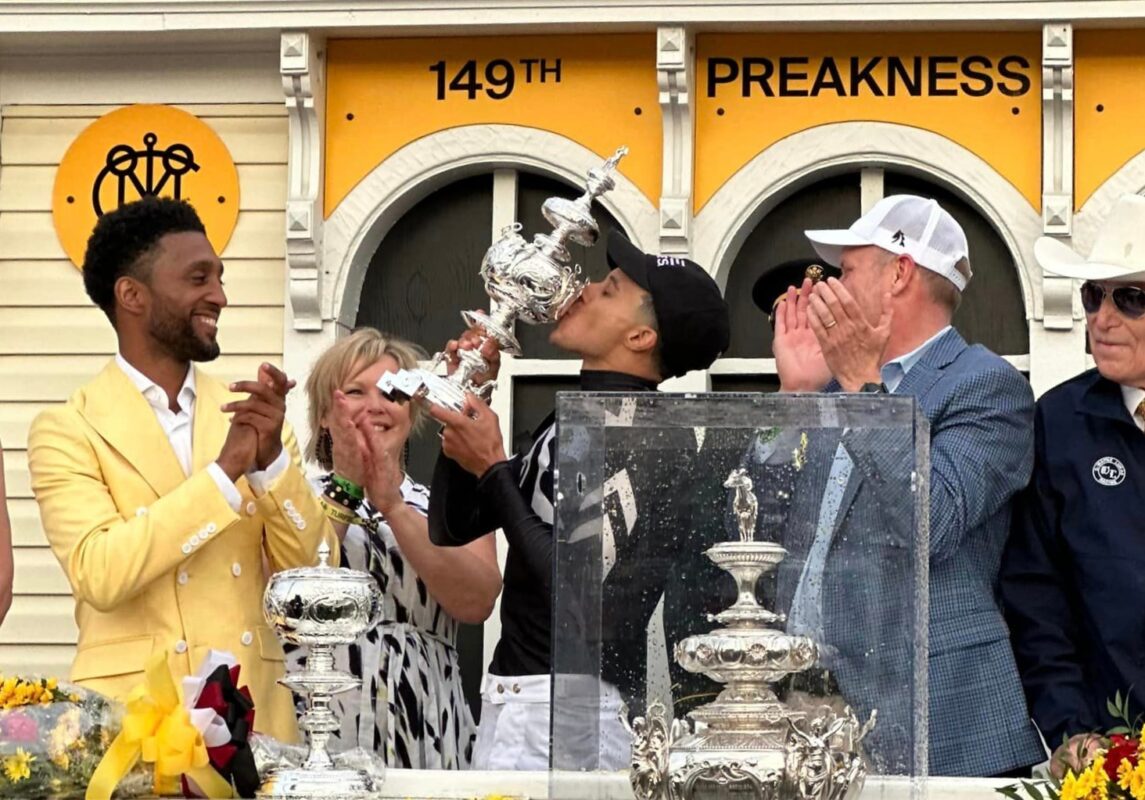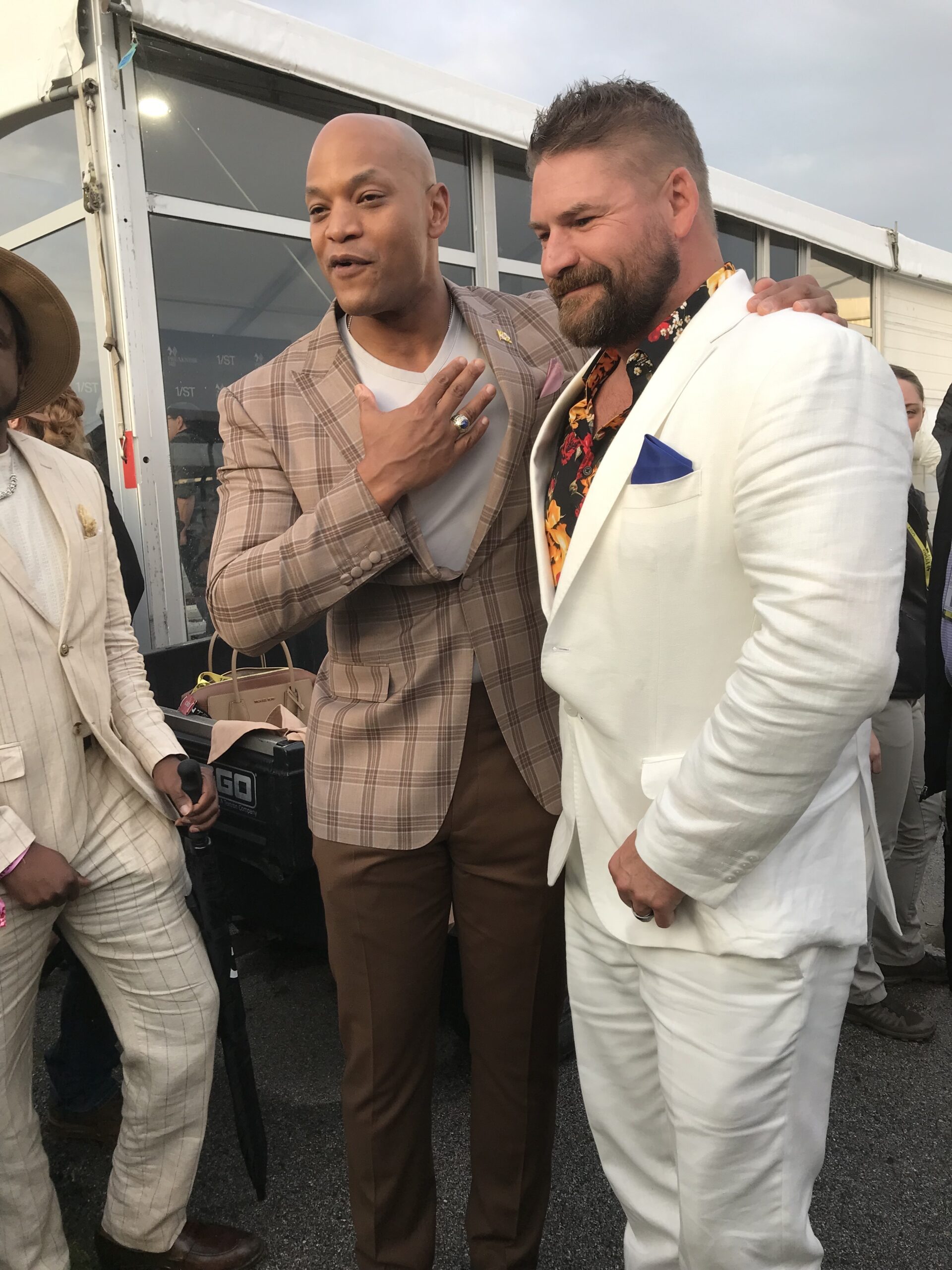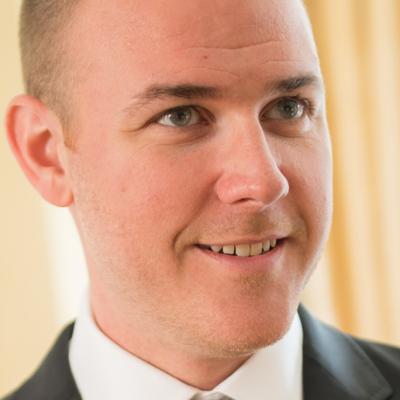
Maryland-born country singer Jimmy Charles had been to Preakness before. “But I was throwing beers up to people on the porta-potties,” he said Saturday afternoon, referencing the infield scene he experienced years ago.
This year, he stood on a black carpet inside the Pimlico Race Course infield near the finish line, wearing a suit, among many others dressed in the same attire. “I definitely wasn’t wearing this, either. This is fancy.”
Now—wearing a white jacket, matching pants, and a red, yellow, and black flowered shirt—he was about to sing the Star-Spangled Banner ahead of the 149th running of the Preakness Stakes, the second jewel of the Triple Crown. “It’s a huge honor,” he told us.
The Ocean City native, who played football at Towson University, mingled Saturday in the infield, where local celebrities—like Baltimore Ravens wide receiver Zay Flowers and outgoing Maryland Senator Ben Cardin—strolled and dodged the rain beneath dry tents.

But the main attraction that got tens of thousands of fans (though certainly not as many as the 140,000 we’ve seen in prior years) to Park Heights on a rainy day, of course, was the horse race itself. Nine-to-one shot Seize the Grey, a name that alludes to the horse’s color, upset favorite and Kentucky Derby winner Mystic Dan. It was 88-year-old trainer D. Wayne Lukas’ 15th Triple Crown victory, seventh Preakness win, and first since 2013.
It was also a $2 million haul for the 2,570 crowd-funded owners of Seize the Grey, 48 from Maryland and some of whom were in attendance. Many of them filled a busy winner’s circle around Lukas, who was aided by a cane.
“I’ve been to some cattle drives that were more organized than that,” Lukas joked at a post-race press conference, sitting next to lead owner Michael Behrens, the founder of the micro-share service MyRacehorse, and jockey Jaime Torres of Puerto Rico, who won his first Triple Crown race. “This place has been a lot of fun for all of us.”
Seize The Grey WINS the 149th Preakness Stakes! 🌻 pic.twitter.com/Uqyb5nXPuS — NBC Sports (@NBCSports) May 18, 2024
Afterward, iconic white-haired trainer Bob Baffert, whose lone entrant Imagination finished seventh out of eight horses, congratulated Lukas on the victory as he walked to accept The Woodlawn Vase.
“If I’m going to get beat, you want to see Wayne win it. He’s creeping up on me,” said Baffert, who has won an all-time record 17 Triple Crown races.
The story of Preakness Day is about the race, pomp and pageantry, and infield revelry, yes, but there’s also always the underlying narrative about the setting itself: Pimlico Race Course, a 154-year-old source of nostalgia for those in the horse racing industry.
Pimlico has long been discussed as a place in desperate need of refurbishing, but a litany of rejuvenation plans have never materialized. As of this week, there is (another) new agreement—for real this time, stakeholders insist (again)—to redevelop decrepit Pimlico.
In a deal announced just a few days ago by Governor Wes Moore and The Stronach Group, which has owned the track since 2011, ownership of Pimlico has been transferred to the newly established Maryland Thoroughbred Racetrack Operating Authority, a state-run nonprofit entity that will operate Pimlico year-round.
With the transfer, the state plans to issue $400 million in bonds to fund a “full renovation of Pimlico facilities,” including the grandstand, track, stables, parking, and new hotel and event spaces. The agreement also calls for $10 million of investment into the neighboring Park Heights community—while The Stronach Group keeps the rights to the Preakness and Black-Eyed Susan Stakes for $3 million annually starting in 2026, and gets a two percent cut of the weekend handle (bets on the races.)
“I’m thrilled that we were able to come to an agreement,” Stronach Group CEO Belinda Stronach said during a state Board of Public Works meeting approving the deal. “This has been a long time coming.”
If all goes according to plan, next year’s milestone 150th running of the Preakness will still happen at Pimlico during construction—which could start early next year. The race will then move to Laurel Park’s track 30 miles south of the city in 2026, and return to a rebuilt Pimlico in 2027.
“The good news is it’s not going to be the last one [here],” Lukas said. “I talked to the governor briefly on the stand up there, and I don’t know the details, but this has been a special place not only for me, but a lot of trainers…They know they’ve got a facility that’s not perfect and they really go all out to make sure that everybody is taken care of and it’s a great spot.
“There’s something about the Preakness—that the intensity and attention and everything between the trainers drops down a little bit, by putting us all in the same barn, sharing the same locker room. The camaraderie comes together. This place becomes special.”
The Stronach Group also owns Laurel, which was a former permanent relocation target for the Preakness. Belinda Stronach told us in 2018 she sought to renovate and create a “supertrack” there. Later, debates in Annapolis ensued, given a state law that requires approval to relocate the Preakness race outside of Baltimore. The new deal keeps the Preakness in the city, and The Stronach Group maintains ownership of Laurel, which the state says it will lease from 2025 to 2027 during renovations at Pimlico.
Until shovels are in the ground and cranes are taking wrecking gear to the property, though, it’s hard to say when and what might ultimately come from all the words and paperwork. And even then, the timeline figures to change if history is any indication.
The most recent example: Back in October 2019, The Stronach Group, the city, and the Maryland Horsemen’s Association agreed to a framework to cede ownership of the track to the city (rather than the state) and fund renovations to Pimlico and Laurel with roughly $335 million in state bonds. But action never materialized, partly because of negotiations over tax implications, post-pandemic inflation, and higher borrowing costs that made the original deal unfeasible.
But back to the main event. (The horses, nor most of the people traipsing the muddy infield and waiting to listen to Jack Harlow on Saturday night, couldn’t care less about all of this, we don’t think.)
Before the race, Charles got things going with his rendition of the National Anthem, and he knew to pause for the “O.”
“I’m very aware,” Charles, who lives in Nashville, said beforehand, mentioning its place in the music video to his 2022 song, “It’s A Maryland Thing, You Wouldn’t Understand.” “If I sing it somewhere else, and I don’t hear the ‘O’, it’s like something went wrong. I always give it an extra breath to let everybody get that out of their system.”
About an hour later, the horses vying for the Preakness were loaded into the starting gate on the soggy dirt. They galloped and thumped down the front stretch, then all the way around the one-mile oval and back in front of the crowd to the finish line.
After crossing first atop his gray-haired ride, Torres threw a fist in the air. And just like that, two minutes after the race began, it was all over until next year.
